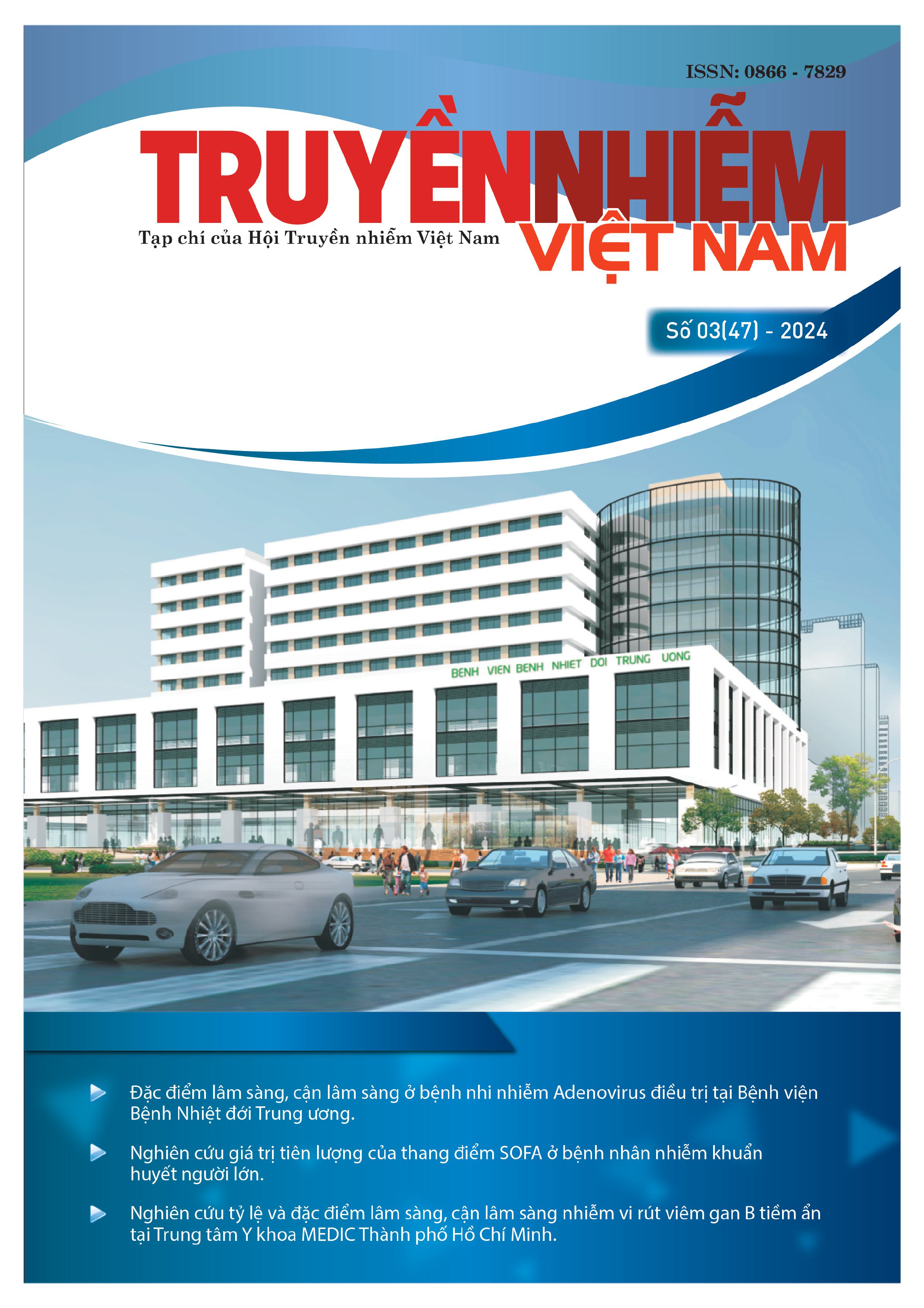EVALUATE THE TREATMENT OUTCOMES OF PATIENTS WITH GASTROINTESTINAL BLEEDING DUE TO PORTAL HYPERTENSION USING ENDOSCOPIC RUBBER BAND LIGATION AT NATIONAL HOSPITAL OF TROPICAL DISEASES
Main Article Content
Abstract
Background: Cirrhosis is a common chronic disease caused by various factors. Rubber band ligation of varices is an effective treatment method for patients with gastrointestinal bleeding (GI bleeding) due
to portal hypertension (PHT). From July 2023 to July 2024, we performed esophageal and gastric varices ligation for 90 cirrhotic patients.
The aim of this study: To evaluate the treatment outcomes of patients with GI bleeding due to PHT using endoscopic rubber band ligation.
Patients and methods: The study involved 90 patients treated with rubber band ligation of varices. This is a descriptive, retrospective study.
Results: Males were more predominant than females (7:1); hepatitis B virus infection and alcohol abuse (82%) were the two most common risk factors in cirrhotic patients. Patients in the Child-Pugh stages B and
C accounted for 67.8%; esophageal varices ligation accounted for the majority (93.3%). The success rate of hemostasis was 95.6%. Chest pain (18.9%) was the most common complication after esophageal varices
ligation.
Conclusions: Endoscopic rubber band ligation of esophageal varices is an effective treatment method with few complications; therefore, it should be performed when indicated to improve treatment outcomesu
quả điều trị.
Article Details
Keywords
Gastrointestinal bleeding, esophageal varcies, portal hypertension
References
2. Vũ Văn Khiên, Bùi Văn Lạc (2002). “Kết quả điều trị thắt tĩnh mạch thực quản cho 20 bệnh nhân”, Y học thực hành, 9, tr. 22-24.
3. Nguyễn Mạnh Hùng, Vũ Văn Khiên, Nguyễn Tiến Thịnh và cộng sự (2011). “Đánh giá kết quả 7 năm thắt búi giãn tĩnh mạch thực quản qua nội soi ở bệnh nhân xơ gan có xuất huyết tiêu hóa do giãn vỡ tĩnh mạch thực quản”, Y học thực hành, 768 (6), tr. 21-24.
4. Vũ Văn Khiên, Vũ Trường Khanh và cộng sự (2012). “Hiệu quả cầm máu và làm mất búi giãn ở bệnh nhân xơ gan có chảy máu tiêu hóa do giãn vỡ tĩnh mạch thực quản”. Tạp chí Gan Mật Việt Nam, 20, tr.40-46.
5. Trần Phạm Chí (2014). “Nghiên cứu hiệu quản thắt giãn tĩnh mạch thực quản kết hợp Propranolol trong dự phòng xuất huyết tái phát và tác động lên bệnh dạ dày tăng áp do xơ gan”. Luận án Tiến sĩ Y học - Trường Đại học Y Dược - Đại học Huế.
6. Lâm Đức Trí (2015). “Nghiên cứu đặc điểm lâm sàng, cận lâm sàng và đánh giá kết quả phương pháp thắt dự phòng thứ phát xuất huyết tiêu hóa do vỡ giãn tĩnh mạch thực quản ở người bệnh xơ gan bằng thắt vòng
cao su kết hợp với Propranolol”. Luận văn chuyên khoa cấp 2 - Trường Đại học Y Dược Cần Thơ.
7. Đồng Đức Hoàng (2018). “Tình trạng xơ hóa thực quản qua nội soi ở người bệnh xơ gan sau điều trị bằng
thắt búi giãn tĩnh mạch thực quản”. Tạp chí Y học Việt Nam, 473(1,2): 125-129.
8. AASLD practice guidelines (2007). “Prevention and management of gastroesophageal varices and
variceal hemorrhage in cirrhosis”, Hepatology, 46 (3), pp. 922-938.
9. Ahmad I., Khan A.A, et al (2009). “Prppranolol, Isosorbide mononitrate and endoscopic band ligation
- alone or in varying combinations for the prevention of esophageal variceal rebleeding”, Journal of
college of physicians and surgeons Pakistan, 19(5), pp. 283-286.
10. Altintas E., Sezgin O., et al (2004). “Esophageal variceal ligation for acute variceal bleeding: Results of
three years’ follow-up”, Turk J Gastroenterol, 15 (1), pp. 27-33.
11. Khalifa A, Rockey DC. Lower Gastrointestinal Bleeding in Patients With Cirrhosis-Etiology and
Outcomes. The American juornal of the medical sciences, 359(4). Pp 206-211, 2020.
12. Petrisor A, Stanescu AMA, Papacocea IR et al., Non-invasive laboratory, imaging and elastography
makers in predicting varices with high risk of bleeding in cirrhotic patients. Romanian journal of internal
medicine = Revue ruomaine de medecine interne, 59(2), pp 194-200, 2021.


